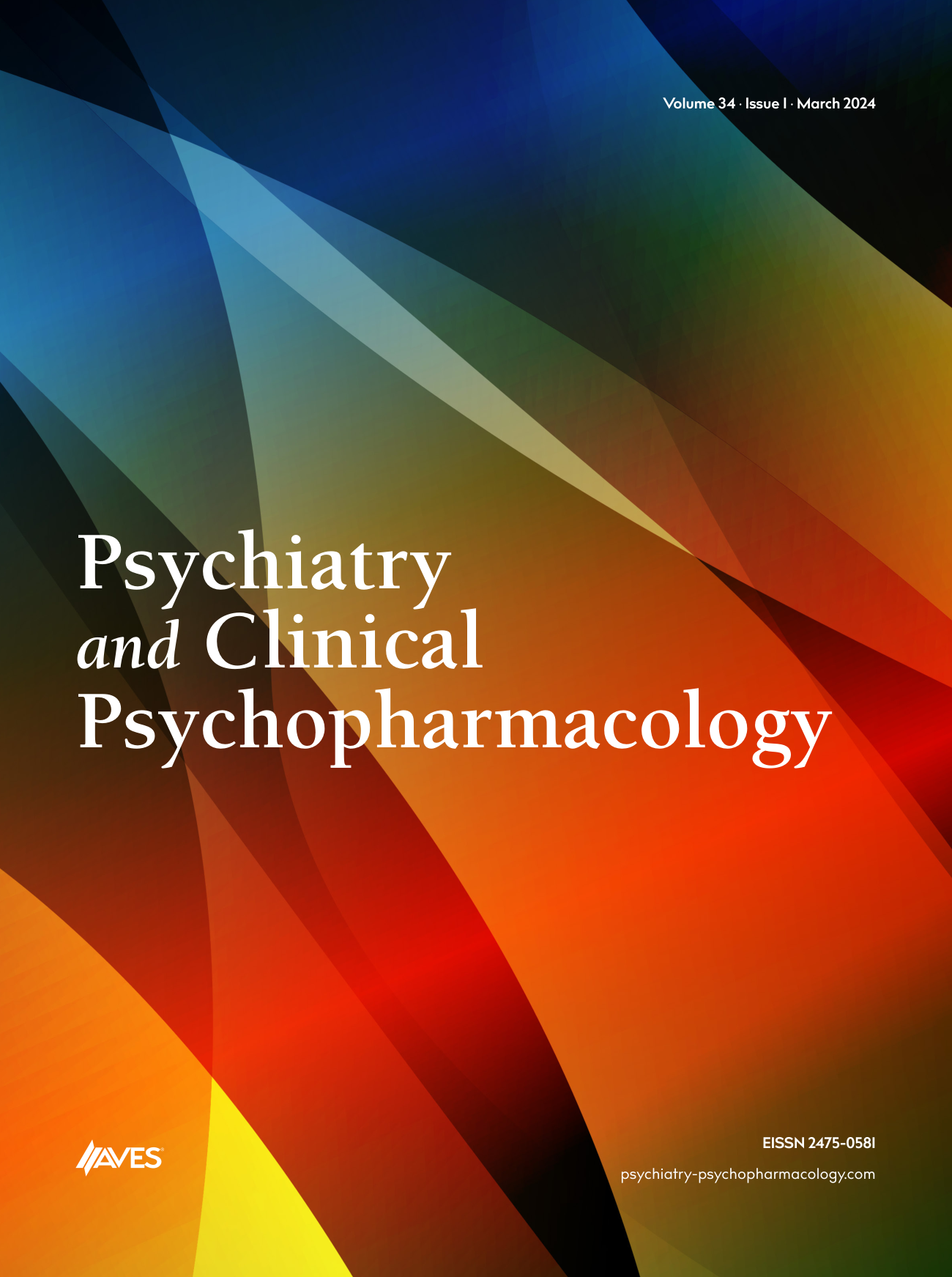Objective: A protective effect of BDNF against ethanol induced cell damage has been suggested, and this effect may contribute to the development of alcohol dependence. Although the mechanisms involved in chronic alcohol treatment–induced neurotoxic actions have not yet been clearly identified, recent studies have hypothesized that prolonged alcohol intake may affect the synthesis of neurotrophins, which are a family of proteins that play a crucial role in cognitive functions, including learning and memory. One of these neurotrophins, BDNF, has a significant role in neuronal development, plasticity, and learning. There are also various study results showing a modulatory role of BDNF in the development and maintenance of addictive behaviour. In this study, we aimed to determine the changes of serum BDNF levels in alcoholic patients at the first and seventh days of withdrawal and compare that to those of healthy controls in order to determine the role of BDNF in alcohol dependence.
Method: A total of 31 male patients suffering from alcohol dependence according to the DSM-IV-TR were admitted for alcohol detoxification treatment and 29 healthy control subjects were enrolled in the study. Patients suffering from psychiatric diagnoses apart from alcohol and nicotine dependence were excluded from the study. Further exclusion criteria were substance abuse other than alcohol or nicotine, severe neurological diseases like cerebral ischemia or haemorrhage, epilepsy, cardiovascular and renal diseases, former delirium tremens, and use of psychopharmacological medication. Alcoholic patients were treated with diazepam in order to prevent alcohol withdrawal symptoms. The dose of diazepam was tapered gradually by monitoring alcohol withdrawal severity (minimum: 30 mg, maximum: 40 mg on day 1) during alcohol withdrawal. The severity of withdrawal symptoms was evaluated by the Clinical Institute Withdrawal Assessment-Alcohol, Revised (CIWA-AR) every eight hours. Blood samples of the patient group were collected on the first and seventh day of alcohol withdrawal, and centrifuged and stored at -70°C immediately after collection. Serum BDNF levels were measured using a sandwich enzyme-linked immunosorbent assay (ELISA). The study was approved by the local ethics committee and all participants gave written informed consent prior to enrollment in the study.
Results: Serum BDNF levels were significantly lower in the alcoholic patients compared with control subjects. (52.9±19.0 ng/ml and 65.3±15.9ng/ml, respectively, p=0.018) Furthermore, BDNF levels were found to be significantly decreased on the seventh day of withdrawal compared to that at baseline. (from 52.9±19.0 ng/ml to 33.5±8.8 ng/ml, p≤0.001). The BDNF levels did not significantly correlate with clinical characteristics such as age, amount of alcohol consumption in the last month, duration of intake, or family history.
Conclusion: This study suggests chronic drinking leads to a reduction in BDNF levels compared to those of healthy controls, implying that BDNF may have a role in the development of alcohol dependence and there is no elevation to that of control BDNF levels in the early alcohol withdrawal period. Further research will be necessary in order to identify the pathophysiological mechanisms and causalities that regulate BDNF plasma levels following alcohol intoxication and withdrawal. These studies should consider both early and late withdrawal periods and should be conducted in large samples in order to identify the association between the disorder and peripheral BDNF levels.
Erken alkol yoksunluğu döneminde serum BDNF düzeylerinin değişimi ve sağlıklı kontrollerle karşılaştırılması
Amaç: Alkolün beyinde yol açtığı nörodejenerasyona koruyucu yanıt olarak ortaya çıkan bir takım değişikliklerin, bağımlılık patogenezinde rol aldığı bilinmektedir. Kronik alkol alımının yol açtığı nörotoksik mekanizmalar tam olarak aydınlatılmış olmasa da, güncel çalışmalarda uzamış alkol alımının, öğrenme ve hafıza gibi bilişsel işlevlerde rol alan protein ailesi olan nörotrofinlerin sentezini etkileyebileceği öne sürülmüştür. Bu nörotrofinlerden biri olan beyin kaynaklı nörotrofik faktör (BDNF) nöronal gelişimde, plastisitede ve öğrenmede önemli bir rol oynar. BDNF’nin bağımlılık davranışının gelişimi ve sürdürülmesinde düzenleyici rolünün olduğuna dair yayınlar vardır. Bu çalışmada alkolik hastalarda yoksunluğun 1. günü ve 7. günündeki serum BDNF seviyelerindeki değişimin belirlenmesi ve sağlıklı kontrollerle karşılaştırılması ve böylelikle BDNF’nin alkol bağımlılığındaki rolünün gösterilmesi amaçlanmıştır.
Yöntem: DSM-IV-TR’ye göre alkol bağımlılığı tanısı konulmuş olan 31 erkek hasta detoksifikasyon tedavisine alındı, 29 sağlıklı erkek kontrol ile karşılaştırıldı. Alkol bağımlısı hastalar yoksunluk semptomlarının önlenmesi amacıyla diazepam ile tedavi edildi. Diazepam dozu alkol yoksunluk şiddeti takibine göre kademeli olarak azaltıldı (minimum:30 mg, maximum:40 mg 1.günde). Alkol yoksunluğu bulguları her 8 saatte bir CIWA-Ar ile değerlendirildi. Kan örnekleri alkol yoksunluğunun 1. gününde ve detoksifikasyonun 7. gününde alınarak santrifüj edildi ve -70’C de saklandı. Serum BDNF seviyeleri ELISA yöntemi ile ölçüldü.
Bulgular: Serum BDNF seviyeleri alkol bağımlıları grubunda, kontrol grubuna göre anlamlı olarak daha düşük saptandı (sırasıyla 52.9±19.0 ng/ml, 65.3±15.9ng/ml, p:0.018). BDNF seviyelerinin yoksunluğun 1. haftasında, bazal değerlere kıyasla anlamlı düzeyde düşmeye devam ettiği gözlendi. (52.9±19.0 ng/ml ‘den 33.5±8.8 ng/ml’ ye, p≤0.001). Yaş, son ayda günlük tüketilen alkol miktarı, ilk alkol kullanım yaşı, alkol kullanım süresi gibi özellikler ve aile öyküsü ile serum BDNF düzeyleri arasında herhangi bir ilişki saptanmadı.
Sonuç: Bu çalışma kronik alkol kullanımının serum BDNF seviyelerinde kontrollere kıyasla anlamlı bir düşüşe neden olduğunu ve yoksunluğun erken dönemlerinde henüz kontrollerin seviyesine yükselmenin olmadığını göstermekte olup BDNF’nin alkol bağımlılığı gelişim sürecinde rol alan bir faktör olduğu bilgisine destek oluşturmaktadır. Alkol yoksunluğunu takiben oluşan serum BDNF düzey değişimleri ile ilişkili olarak altta yatan patofizyolojik mekanizmaların daha net olarak ortaya konması bakımından ileri araştırmalara ihtiyaç vardır. Gelecekte bu alanda yapılacak çalışmaların, alkol bağımlılarında yoksunluğun erken ve geç dönemlerini kapsayacak şekilde ve daha geniş örneklemde yapılması, periferik BDNF düzeyleri ile hastalığın ilişkisinin daha net ortaya konması açısından önemlidir.



